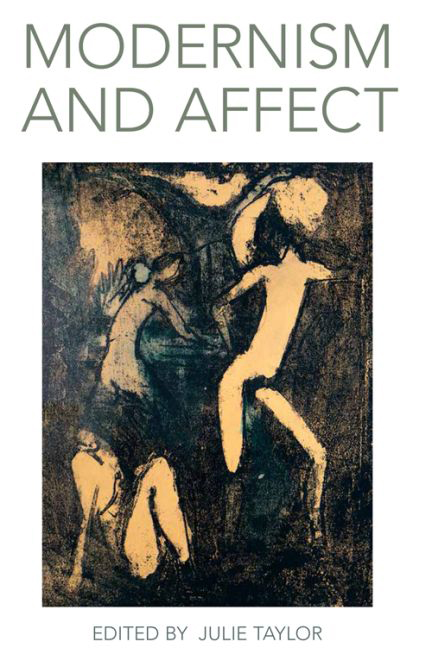Book contents
- Frontmatter
- Contents
- List of Illustrations
- Acknowledgements
- Notes on Contributors
- Introduction: Modernism and Affect
- 1 Mind, Body and Embarrassment in Henry James's The Awkward Age
- 2 The Trauma of Form: Death Drive as Affect in À la recherche du temps perdu
- 3 Logic of the Heart: Affective Ethical Valuing in T. E. Hulme and Max Scheler
- 4 The Line that Binds: Climbing Narratives, Ropework and Epistolary Practice
- 5 The Amplification of Affect: Tension, Intensity and Form in Modern Dance
- 6 Love and the Art Object
- 7 Animating Cane: Race, Affect, History and Jean Toomer
- 8 Fear and Precarious Life after Political Representation in Baudelaire
- 9 Bloom-Space of Theory: The Pleasure and the Bliss of Gerty MacDowell
- 10 From Odysseus to Rotpeter: Adorno and Kafka, Mimicry and Happiness
- 11 Making Happy, Happy-making: The Eameses and Communication by Design
- Index
4 - The Line that Binds: Climbing Narratives, Ropework and Epistolary Practice
Published online by Cambridge University Press: 15 September 2017
- Frontmatter
- Contents
- List of Illustrations
- Acknowledgements
- Notes on Contributors
- Introduction: Modernism and Affect
- 1 Mind, Body and Embarrassment in Henry James's The Awkward Age
- 2 The Trauma of Form: Death Drive as Affect in À la recherche du temps perdu
- 3 Logic of the Heart: Affective Ethical Valuing in T. E. Hulme and Max Scheler
- 4 The Line that Binds: Climbing Narratives, Ropework and Epistolary Practice
- 5 The Amplification of Affect: Tension, Intensity and Form in Modern Dance
- 6 Love and the Art Object
- 7 Animating Cane: Race, Affect, History and Jean Toomer
- 8 Fear and Precarious Life after Political Representation in Baudelaire
- 9 Bloom-Space of Theory: The Pleasure and the Bliss of Gerty MacDowell
- 10 From Odysseus to Rotpeter: Adorno and Kafka, Mimicry and Happiness
- 11 Making Happy, Happy-making: The Eameses and Communication by Design
- Index
Summary
In ‘An Inventory of Shimmers’, Gregory Seigworth and Melissa Gregg suggest that affect is ‘integral to a body's perceptual becoming’ (2010: 3), part of a process in which that body is ‘pulled beyond its seeming surface-boundedness by way of its relation to … forces of encounter’ (ibid.). Through affect, they claim, a body is ‘webbed in its relations’ (ibid.). In the early twentieth century, two models suggest themselves as both allegories for and instantiations of such webbed relations: letter writing and mountaineering. Epistolary practice, in its combination of bodily sensations (as writer or recipient) and of identity formation (in a conversational duet with one's addressee), along with its connections to others in a network facilitated by postal services, pulls individual identity and intimate bodily experience into relation with others, using the handwritten line. Mountaineering makes use of the rope strategies of the belay, tying together participants in ways both physical and emotional in a binding that ‘shimmers’ between the literal and the metaphorical. Using the figures of George Mallory and Virginia Woolf, mountaineer and author, this chapter explores the ways in which letter writing and mountaineering can both be considered as activities of the binding line. For Mallory, one's passage up the rock face is a form of script, while the letter sends forth the looped line of the belay to attach the addressee. For Woolf, letter writing may suffer the perilous line break of mountaineering, while climbing scenes afford the opportunity to consider the potential of epistolary practice as a literature of the moment, a temporary tie. Mountaineering and letter writing are in this way bedfellows, albeit unlikely ones, since their binding lines, on mountainside and page, generate narratives of affect.
Mallory and Marjorie
From 1923 until his death on the slopes of Everest on 8 or 9 June 1924 (the precise moment of his end being unconfirmed), Mallory maintained a correspondence with Eleanor Marjorie Holmes (known as Marjorie), a teacher of no official qualifications working at a private school in Bentham, Yorkshire. The correspondence was of both an intense order and a peculiar kind, since the two had never met in the flesh.
- Type
- Chapter
- Information
- Modernism and Affect , pp. 75 - 93Publisher: Edinburgh University PressPrint publication year: 2015



